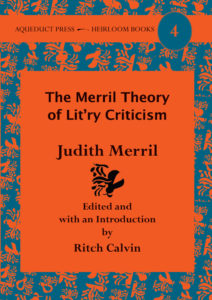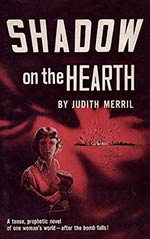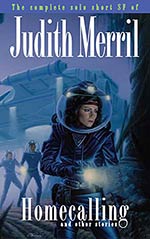Judith Merril’s Take On Classic Science Fiction
 I have to thank Aqueduct Press (“Bringing Challenging Feminist Science Fiction to the Demanding Reader”) for publishing The Merril Theory of Lit’ry Criticism by Judith Merril. If you have sufficient years reading science fiction you’ll remember the annual SF collections of best short stories Judith Merril edited back in the 1950s and 1960s. What Ritch Calvin has done is collect all her introductions and summaries from those 1956-1969 annual anthologies, 38 book review columns from The Magazine of Fantasy and Science Fiction (1965-1969), and a few additional essays from Extrapolation, a journal devoted to studying science fiction. For ebook readers, he also includes the introductions to all the short stories from all the anthologies. That’s 622 pages (ebook) or 360 pages (paperback) of commentary on science fiction, a goldmine of insight into old science fiction. Both editions are available from Amazon or the publisher, and hopefully your local bookstore.
I have to thank Aqueduct Press (“Bringing Challenging Feminist Science Fiction to the Demanding Reader”) for publishing The Merril Theory of Lit’ry Criticism by Judith Merril. If you have sufficient years reading science fiction you’ll remember the annual SF collections of best short stories Judith Merril edited back in the 1950s and 1960s. What Ritch Calvin has done is collect all her introductions and summaries from those 1956-1969 annual anthologies, 38 book review columns from The Magazine of Fantasy and Science Fiction (1965-1969), and a few additional essays from Extrapolation, a journal devoted to studying science fiction. For ebook readers, he also includes the introductions to all the short stories from all the anthologies. That’s 622 pages (ebook) or 360 pages (paperback) of commentary on science fiction, a goldmine of insight into old science fiction. Both editions are available from Amazon or the publisher, and hopefully your local bookstore.
Judith Merril was an exceptionally well-read reviewer, not only referencing a detailed knowledge science fiction and its history, but literary works and science books. She was also pithy, funny and to the point. Here’s her 1965 review of PKD’s latest, where at the end of a previous book review had stated, “Philip Dick did it better three years ago, in The Man in the High Castle.” She then continues…
The Three Stigmata of Palmer Eldritch, Philip K. Dick, Doubleday, $4.95, 278 pp.
I don’t mean, this time, that his new book is similar in theme or treatment. Rather, that I wish it were more so, at least in characterizations and structure. Phil Dick is, one might say, the best writer s-f has produced, on every third Tuesday. In between times, he ranges wildly from unforgivable carelessness to craftsman-like high competence. In the case of Palmer Eldritch, I would guess he did his thinking on those odd Tuesdays, or rather on one of them, and the actual writing in every possible minute before another Good Tuesday came on him. Here is a riotous profusion of ideas, enough for a dozen novels, or one really good one; but the stuff is unsorted, frequently incompleted, seldom even clearly stated. The style is alternately dream-slow-surreal and fast-action-pulp. Thematically, he at least approaches, and sometimes stops to consider, virtually every current crucial issue: drug addiction, sexual mores, over-population, the economic structure of society, the nature of the religious experience, parapsychology, the evolution of man — you name it, you’ll find it. The book, with all this, is inevitably colorful, provocative, and (frustratingly) readable. I wish I thought it possible that Dick might some time go back to this one, publication notwithstanding, and finish writing it.
One reason why I immediately hit the buy button for The Merril Theory of Lit’ry Criticism is because I bought her anthologies a half-century ago, and started reading F&SF around that time too. For years now I’ve been meaning to order those anthologies used from ABEBooks, just so I could read the commentaries. To have Calvin throw in all the book reviews was too good to be true, but it is.
I’ve been hung up on my science fictional past, and this book is perfect for retracing steps I first took in 1965. Anyone who collects old SF from that era will find this volume to be a treasure chest of clues.
Merril, on occasion, had a lot to say about a book. She often read a book more than once to write a review. She was determined to understand science fiction at a level beyond what most readers ever try. Look at this review of Nova by Samuel R. Delany, one the more memorably SF books from the 1960s. I probably read this review at the time too. This is a great example of what Merril does when she goes long:
Leave your preconceptions behind, again, when you open Samuel Delany’s new Nova (Doubleday, $4.95). My own problem was the opposite of my friend’s with 2001: I came to this book with an anticipation keener than any I have brought to anything since — well, probably Vonnegut’s Rosewater — looking for (at least an approach to) the Great Novel I (still) expect from the author of Empire Star, Babel-17, The Einstein Intersection, “The Star-Pit,” “Aye and Gomorrah,” and (now) Nova: and what I got instead was a first-rate jim-dandy solid provocative science-fiction novel.
It took me a while to realize I had no honest cause for complaint — a while longer to discover I damn well did have cause — longer yet to understand (first) why I was so irritated, and (eventually) the real reasons to be annoyed with the book.
Delany is in an almost unique position in s-f today: everybody loves him. The “solid core,” the casual readers, the literary dippers-in, the “new thing” crowd — Delany is all things to all readers. It is an untenable position — unless, of course, he gets as good as I think he will eventually be. Swift, Melville, Carroll, Twain, Conrad are all read by children as well as litterateurs, their plots are reducible to comic book format, while their themes are subtle and complex enough to sustain reading after delighted analytical reading.
Well, Delany is not Swift or Conrad — yet; but his seven previous novels and scattered shorter works have already placed him out of the judging in the transient-writer class; and as the work of an apprentice-great, Nova must be regarded as more of a fascinating exercise than a satisfactory achievement. But —
What is wrong with the book is simply that the author tried to do — not too much, but enough: he tried to write a modern novel on all the levels required (by the same standards I am applying) of a contemporary work: if he did not quite succeed, it is well to remember that neither has anyone else — yet; and few other attempts have managed to stand up meanwhile as, at least, solid entertainment.
Here is what I wrote after my first reading of the book:
Nova is a deceptive book in several ways. Don’t let the first page stop you; the book is not — except superficially — a Planet Stories superficiality. And don’t rush in to identify with anyone too soon; it may take a while to decide whose viewpoint you are using.
The protagonist, the hero, and the viewpoint character are (in order of appearance, not necessarily identity) a 19-year-old gypsy-born spacehand-and-minstrel named the Mouse; a cosmically wealthy and powerful space captain named Lorq Von Ray; and a wandering scholar and spacehand called Katin.
The book is intriguingly, but unnecessarily, complex — mostly written underwater, as it were; that is, under the surface of a (too) familiar space adventure plot, as warm and sparkling with the strange and rich biota of Delany’s inner world.
There is, for instance, the Mouse’s “sensory-syrynx,” an instrument which can produce a complete multi-media show — visual, musical, and olfactory display; a recurrent theme involving Tarot lore; a carefully constructed cultural context in which the 20th century serves as the classical period of a culture 1000 years older, whose technological and philosophic beginnings are rooted in the transitions of today. There are the Illyrion furnaces which have made whole planets habitable and space traversable, great glowing pits called Hell here, and Gold there — and tiny battery power packs primed by micrograms of the same stuff, which run the wondrous syrynx and Katin’s tiny recorder. There is a gorgeous physiological/astrophysical/political philosophic construct in parallels; and a sweep of action from Athens to the Pleiades, with fiery fights, drinking bouts, mosques and museums, diver-hunters and cyborg-spacemen — and with all this, the book is somehow lacking. I do not know what it lacks; perhaps if it had come after Empire Star and Babel-17, and before The Einstein Intersection, I should have found no lack, at all. But, just as I went on from the first banal page, simply because it was Delany, and I could be sure of finding the richness and excitement I did find, so I went on from history lesson to battle scene to gorgeous syrynx session to Tarot lore, hoping I could be equally sure of learning why they were all there together. I think an explanation was given to me in the last pages — and I do not think it satisfied me. But never mind: the fans will love it.
That was the first time around; I have now read the book — to be precise — two and a half times (the third time, only those passages marked the second time for re-examination), and when I started to retype that earlier comment, I thought the word unnecessarily must have been a typographical error. Alas, not so: the error was not mechanical, but (doubly) human — the reader’s and writer’s both.
There is nothing in this book that did not have to be there — from the blind drunk of the spacebars to the wicked gorgeous Princess, Ruby Red; from the syntax-inversion of the Pleiades speech-pattern to Katin’s erudite lectures; from the cool halls of the Alkane Institute to the hole in the stellar doughnut. The problem is rather that some elements are so compressed as to be almost invisible, and I question whether any reader who lacks the responsibility of recording his opinion will work as hard as I did to find, and put together, all the pieces in a book so readily readable and pleasingly paced on the surface that there is no real cause to wonder how deep the channels underneath may flow — and small sign of their turbulence.
These are (at least some of) the ways you can read Nova: as a fast-action far-flung interstellar adventure; as archetypal mystical/mythical allegory (in which the Tarot and the Grail both figure prominently); as modern-myth told in the s-f idiom with powerful symbols built on solid science fiction clichés; as a futuristic vehicle for a philosophic complex of political/historical/economic/sociological ideas; as an experimental approach to literary criticism.
Among other things, the book examines: the nature and value of scholarship, mysticism, “progress,” and the varieties of the creative experience; the significance of the “instinct for workmanship” (the quote is from Veblen, not Delany) and the alienation phenomena of the industrial and (current) electronic revolutions; the relationships between the psychophysiology of the individual and the ecology of the body politic. Each of the three central characters (or the three aspects of the character?) suffers a variant form of alienation, rooted in different combinations of social, economic, geophysical, cultural, intellectual, and physiological factors. Through one or another of these viewpoints, the reader observes, recollects, or participates in a range of personal human experience including violent pain and disfigurement, sensory deprivation and overload, man-machine communion, the drug experience, the creative experience — and interpersonal relationships which include incest and assassination, father-son, leader-follower, human-pet, and lots more.
The economy of Delany’s writing is both maddening and delightful — and almost accomplishes what he seems to have been trying to do. (For instance, the culture-vista opened up when the Lunar scholar, Katin, says to the gypsy Mouse: “If somebody had told me I’d be working in the same crew, today in the 31st century, with somebody who could honestly be skeptical about the Tarot, I don’t think I would have believed it. You’re really from Earth?”) But even 279 closely written, richly embroidered, tautly thought pages are not enough: it is too much of too many, and too little of each: and — add odd complaints — it is too easy to read, on the easiest level.
If you let yourself go, it will run away with you; since the author failed to set up stop signs, the reader must either make his own (put the book down and pace the room once between chapters?) or plan on a second, slower reading after the fun of the first. Or settle, of course, for a good read, and never mind mining out the gold.
For two writers so disparately individual in concept, mood, style, background, and viewpoint Delany and R. A. Lafferty have certain startling distinctions in common. There are other notable stylists and fine prose writers in s-f today; but — in very different modes — Lafferty and Delany are currently the two outstanding poetic writers (language both lyrical and precise; images exact and evocative). There are other evolving new concepts and working out appropriate new techniques for contemporary multiplexities; and there are many others writing action-adventure yarns in the s-f idiom; but I can think of no others who so frequently manage to combine these apparently contradictory efforts.
But their greatest similarity also contains their most symptomatic difference. Among the characters in both men’s stories, a strange breed of children appear repeatedly: hardheaded/mystical creatures with electric personalities and powerful capacities. In Delany’s stories they are most often young teenagers whose essentially heroic proportions and proclivities (like almost all Delany characters) are dramatically flawed, or defective, or incurably disadvantaged, in some one area. Lafferty’s children are mostly prepubescent, and perfectly normal — except for a total lack of (parental or personal) inhibition; and a sort of amplification — of reality which permits them to act out archetypal childish fantasies on a grand-opera heroic scale.
 By the way, Nova, as well as Babel-17 and Dhalgren have been recently produced for audio, and are available at Audible.com. I waited over a decade for Delany to come to audio, and the wait was well worth it, because hearing Delany read by a professional makes his rich narrative come alive in myriads of ways my own inner voice fails to find. I beg the audiobook producer gods to please come out with Distant Stars and Aye, and Gomorrah: And Other Stories next. They contain the short novel and novella, Empire Star and “The Star Pit” which are my absolute favorite science fiction stories form the 1960s.
By the way, Nova, as well as Babel-17 and Dhalgren have been recently produced for audio, and are available at Audible.com. I waited over a decade for Delany to come to audio, and the wait was well worth it, because hearing Delany read by a professional makes his rich narrative come alive in myriads of ways my own inner voice fails to find. I beg the audiobook producer gods to please come out with Distant Stars and Aye, and Gomorrah: And Other Stories next. They contain the short novel and novella, Empire Star and “The Star Pit” which are my absolute favorite science fiction stories form the 1960s.
If you’re the kind of science fiction fan I am, old and looking backwards, analyzing a lifetime of reading, The Merril Theory of Lit’ry Criticism is a book you won’t want to miss. The ebook is a real convenience, letting us read a few reviews on our phones whenever a free moment pops up.
 Judith Merril also wrote science fiction, not much, but enough to make her one of the pioneer women writers of science fiction starting in 1948 with her classic short story, “That Only a Mother” appearing in Astounding. She wrote two novels on her own, Shadow on the Hearth (1950) and The Tomorrow People (1960), and two novels with C. M. Kornbluth as Cyril Judd, Gunner Cade (1952) and Outpost Mars (1952). Shadow on the Hearth and the two Cyril Judd novels have been collected by NESFA Press as Space Out: Three Novels of Tomorrow by Judith Merril and C. M. Kornbluth. The Tomorrow People is currently in print from Armchair Fiction, a company that reprints a great deal of forgotten science fiction.
Judith Merril also wrote science fiction, not much, but enough to make her one of the pioneer women writers of science fiction starting in 1948 with her classic short story, “That Only a Mother” appearing in Astounding. She wrote two novels on her own, Shadow on the Hearth (1950) and The Tomorrow People (1960), and two novels with C. M. Kornbluth as Cyril Judd, Gunner Cade (1952) and Outpost Mars (1952). Shadow on the Hearth and the two Cyril Judd novels have been collected by NESFA Press as Space Out: Three Novels of Tomorrow by Judith Merril and C. M. Kornbluth. The Tomorrow People is currently in print from Armchair Fiction, a company that reprints a great deal of forgotten science fiction.
Merril produced several short story collections: Out of Bounds (1960), Daughters of Earth (1968), and Survival Ship and Other Stories (1974), each of which has been repackaged a number of times, but all her stories are currently available as Homecalling and Other Stories: The Compete Solo Short SF of Judith Merril (2005), again from NESFA Press.
I hope both the NESFA books come to audio.



















 Full Details
Full Details


